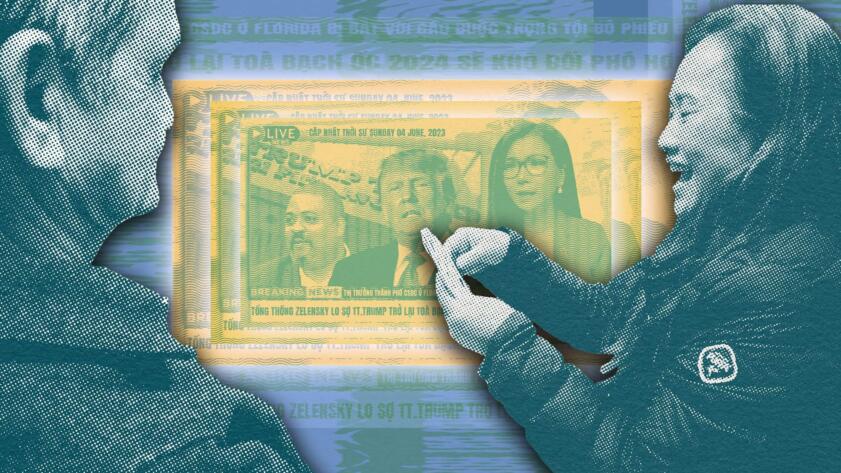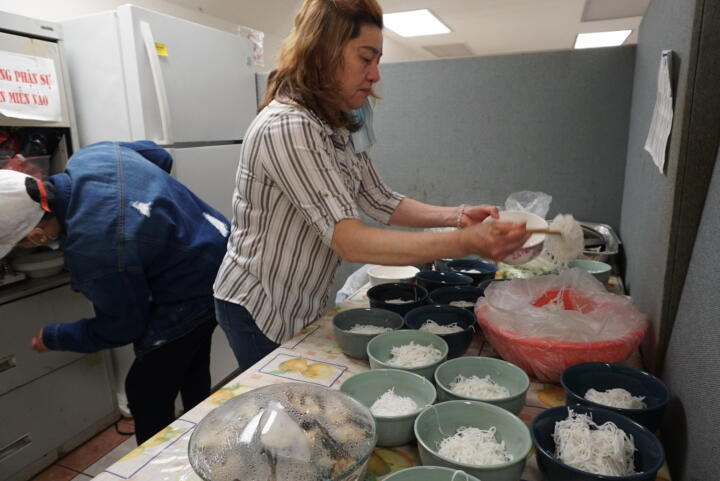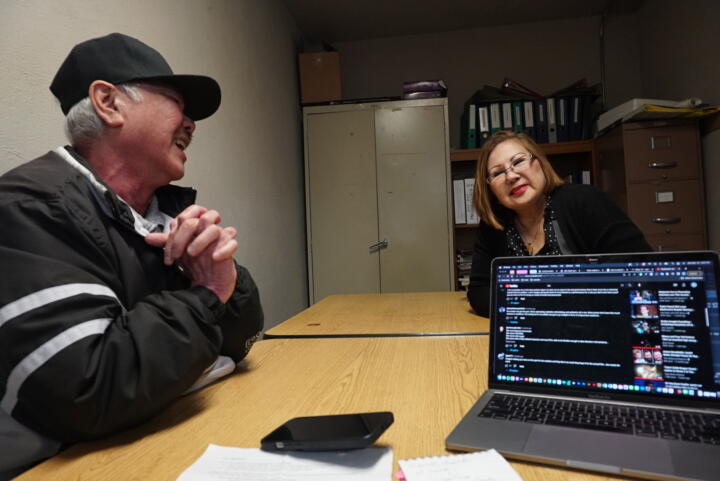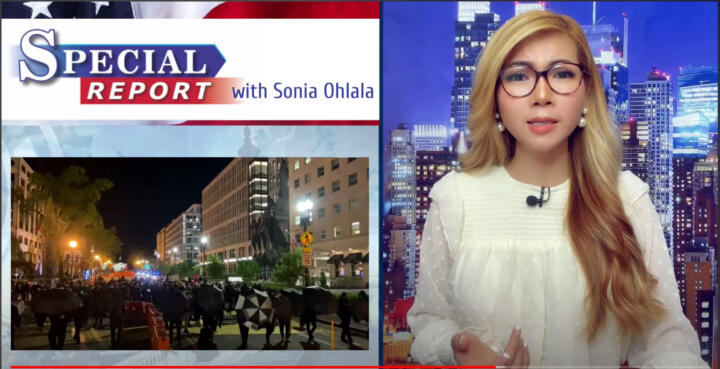This article is copublished with The Oaklandside, a nonprofit newsroom that amplifies community voices, shares trustworthy information, and investigates systems, not symptoms for Oakland, Calif.
Sonia Ohlala’s YouTube videos usually begin with a friendly greeting in Vietnamese. From the grandpas and grandmas out there, ông and bà, to the uncles and aunties, cô and chú, to her peers, anh and em, she wishes them all kind regards and hopes that they are in good health. She talks with a warm respect in her voice—the kind that’s culturally expected of you, if you are a younger member of the family. Without missing a beat, she then launches into a Vietnamese broadcast of the latest news, starting with Donald Trump.
“Let me show you a beautiful photo of Donald Trump as he is playing golf,” she said in one video published on May 26, 2023. “He bends down and picks up golf balls, like it’s not a problem.[…] He’s a very healthy person at 76.” Even though he has not been president in the past two years, most of Ohlala’s YouTube broadcasts revolve around the former president, translating content from far-right outlets like Newsmax, The Gateway Pundit, or Breitbart, according to her public YouTube community page.
For some Vietnamese immigrants to the U.S., like Oakland resident Duyen Hoang, 56, Ohlala’s videos are one of the few U.S. news sources she can access, because they’re in Vietnamese. Hoang watches Ohlala regularly on YouTube and believes Donald Trump is a good and accomplished man, even if she knows that Ohala’s videos may not always be based on reliable information—or be giving her the local news she sorely needs.
“I really just need more information about my hometown Oakland,” Hoang said.
As part of an Information Futures Lab fellowship at Brown University, I spoke to Hoang and about two dozen fellow community members to better understand what role Ohlala and other YouTubers play in their community. Hoang also gave me access to her entire YouTube archive so I could understand the context of how these videos show up in her feed.
When I asked community members where they get their news, only a handful of people said they tuned into the local TV station or read any local English language articles. They used to have to wait for a weekly newspaper, Tuần báo Mõ, produced in nearby Sacramento to get news in Vietnamese, they said. But now everyone used YouTube to receive information, and almost everyone seemed to know Ohlala.
“We no longer have to wait for news,” said Long Van Nguyen, 76, who also watches Ohlala’s videos. “Now we can get news as soon as we open our eyes in the morning.”
YouTube broadcasters like Ohlala cater to immigrant communities in the U.S. who speak little to no English, who are often starved for information about their immediate environment and have limited options for where they can get their news. After examining dozens of Ohlala’s videos and speaking with experts, The Markup found that news aggregators and commentators like Ohlala often omit information that would give the news cultural or historical context, and, in Ohlala’s case, her content is repackaged from right-wing organizations.
The Markup reached out multiple times to Ohlala to request an interview but did not receive any response before publication. In the description of a second YouTube channel, she wrote: “… due to Youtube censorship, Sonia has added a second backup Youtube channel. Sonia does not cooperate with other stations or Youtube sites.”
This community has a problem that many immigrant communities have: It needs reliable information about the community in its language. While some national and international news organizations deliver news in Vietnamese, such as the Vietnamese services of the BBC or French radio broadcaster RFI, only a few outlets deliver online information in Vietnamese about the U.S., let alone regional news relevant to the Bay Area.
This need for quality news became even more pertinent in the past few years. Hoang and many other members of the community found themselves lost in a sea of information and misinformation about COVID-19. Her need for quality news was heightened further when she started feeling more and more unsafe in her neighborhood as an Asian immigrant. Around the country there was a surge of hatred against Asians, with anti-Asian hate crimes increasing by 339 percent in 2022 according to data compiled by the Center for the Study of Hate and Extremism. Headlines about brutal attacks against Asian men and women across the country made national news. Anti-Asian hate became prominent at a time when President Donald Trump dubbed COVID-19 the “China virus.”
This community felt this in their neighborhood. The pandemic brought about the most unequal recession recorded in U.S. history, and it took a particularly devastating toll on Black and Latino communities, which was felt in the Bay Area as well. In tandem, the city of Oakland saw a rise in homicides (though this trend has reversed most recently). Vietnamese community members experienced this by word of mouth, too: They heard about a friend who was beaten and whose necklace was stolen. They heard of a Vietnamese-owned coffee shop being robbed. At the same time, the entire nation and Oakland were embroiled in a “racial reckoning” that brought about protests, clashes with police, and, in some rarer cases, looting across the country and in Oakland.
Imagine experiencing all this without a news organization delivering you information in the language you understand. Where do you turn? Who can help you clarify all these complex and concurring issues? This particular community largely turned to YouTube.
A DIY Community Will Get DIY News
Hoang is part of a small group, started by my uncle, of about 100 Vietnamese immigrants in Oakland who regularly meet on Saturday mornings. Most came to the U.S. in the 1990s as part of an asylum program specifically targeting former political prisoners.
My uncle, a political prisoner himself, started bringing people together 30 years ago to help other former political prisoners. Over time, he expanded to help the Vietnamese community at large. Some people are in their 50s and several are in their 70s. All were born in Vietnam and came to the U.S. well into their adulthood. A handful of them speak enough English to have basic conversations, but the majority of them conduct their daily lives, including getting the news, entirely in Vietnamese.
Every Saturday morning they rent out a basement and get together to sing and help one another. When I joined them one Saturday in March, one of the members had his laptop wired to a television set. He was searching YouTube for karaoke versions of Vietnamese songs that they sing together every week. A couple of women were making lunch together, using ingredients they bought during the week at Vietnamese supermarkets.
Amid these joyful gatherings, they also do vital things that are important to the well-being of this community: administering yearly flu shots, participating in neighborhood activities like street cleanups, and assisting each other with voter registration.
This is not unique to the Vietnamese community. There are countless DIY care networks within Asian and other immigrant communities that swoop in where government entities have failed. They’ve organized microgrants, self-defense, and food distribution to help ailing Chinatown businesses. The Asian community has also taken security into its own hands as community members have felt sidelined by both local politicians and police forces that help only when it’s too late.
This feeling of neglect is also reflected in how this community perceives most news outlets. Despite their neighborhood being roughly 20 percent Asian, members of the group told me they often feel overlooked by the mainstream media.
In response, many members of this group have adopted a way of building DIY self-help methods to inform themselves. They exchange information about their neighborhood and the latest news or what they read about in Tuần báo Mõ, which they can pick up during their community gatherings. If a crime happens in a Vietnamese business nearby, the group messages each other in group texts or on Facebook to keep an eye out. They said that once, when they called police, officers only showed up hours after the incident and were not of help. They also said that English-language media only rarely cared about what was going on in their community.
Tuyet Nguyen, 70, for example, says that in the morning he puts on the local TV station, turns on the closed captioning, and “then I can understand a little.” But for most news about current events and politics he turns to YouTube. There, he receives news about ongoing events in his home country through YouTube channels based in Vietnam. And that’s also where he looks for more information about American news, often relying on algorithmically produced recommendations to discover content.
“There’s a lot of news about Trump or Biden” on YouTube, he said. “We can’t watch only one video. We have to watch different ones—watch this channel and another channel—and we combine them to see what’s right.” He said he watches a lot of Ohlala’s videos.
Hoang’s watch and search history on YouTube reflects this DIY approach, too. Her viewing history dates back to 2020. From it I can tell that Hoang uses YouTube to help her make better decisions about her life: from spiritual guidance from Buddhist monks to instructional cooking videos to getting medical advice.
To get a better understanding of the breadth and depth of what Hoang watches on YouTube, with her permission I categorized a random sample of 1,000 videos from her archive. “News” represents videos with information about current events and politics from various sources, such as vloggers who discuss the news and official news organizations based in Vietnam. “Entertainment” represents films and talk-show-like content that discuss lifestyle issues and music (many were karaoke versions of songs). “Health” includes information about symptoms of a sickness or the health benefits of certain foods. “Instructional videos” teach, for example, by showing viewers how to cook a dish or care for plants.
It’s only natural that Hoang and her peers would also find news on the platform. And unlike other news organizations, Ohlala and other YouTubers meet her where she already is.
News out of Context
When Black Lives Matter protests filled the streets in Oakland, this community said they became afraid of looting. Viral imagery of Black men shoving and beating older Asian adults also increased their fear. Amid national headlines around protests and anti-Asian hate, they did not have much information they could act on or use to understand underlying issues. (Looting narratives around protests have a long history of distracting from mostly peaceful protests in the U.S., according to Time.)
A search of Ohlala’s videos for any mention of the BLM movement only returned one video, which was broadcast after police in Brooklyn Center, Minn., and Chicago, Ill., killed a Black man, Daunte Wright, and a Latino boy, Adam Toledo, in 2021. Ohlala explains that there have been many Black Lives Matter protests in Washington, D.C., but she does not mention the deaths of Wright or Toledo or any information about what sparked the protests. Instead, she talks about a Telegram text message exchange, which focuses on one woman’s bad experience with Black women. Ohlala then gives recommendations to Vietnamese folks to not speak to Black people and avoid conflict. She says that some Black people, under Biden, “have received a waiver to be more aggressive.”
There are sweet and kind Black people, too, she said. But she also said to avoid conflict with Black people, even on the streets.
In recent years, a network of news aggregators (some of which are anonymous) has cropped up on social media and focuses heavily on amplifying violent incidents where attackers were Black and victims were Asian, according to an August 2020 report about disinformation from the National Council of Asian Pacific Americans and the Disinfo Defense League. The stories and social posts are often rewritten news articles with eye-grabbing headlines or reports of old incidents that aggregators use as proof that official channels are underreporting anti-Asian crimes perpetrated by Black people, weaponizing the victimhood of Asians, the report stated. One headline on an Instagram account identified by the report: “Black-on-Asian violence claims another life in New York City.” “Nearly every other day, it seems an Asian-American is attacked or murdered by criminal elements within the African-American community,” the caption of the post said.
“The documented lack of coverage about Asians and Asian Americans in mainstream media and news have left voids filled by sources and online hubs … with a singular emphasis on ‘pro-Asian’ identity,” the report said. “These spaces foster problematic narratives that pivot on existing structures of misogyny, anti-Black racism, and xenophobia.”
Much of the discourse around combating this kind of hyperpartisan misinformation centers on either debunking false claims or translating news from mainstream information. But this approach doesn’t take context into consideration.
Getting contextual information about their immediate environment is really about “livelihood issues,” said Nick Nguyen, a volunteer with the nonprofit Viet Fact Check. The organization publishes summaries of trustworthy reports from mainstream media organizations or academic papers in Vietnamese and contextualizes the information so it culturally makes more sense for the Vietnamese community.
And so the harms when you don’t have [quality] information coming from other sources … can actually be quite severe.
Nick Nguyen, Viet Fact Check
Instead of framing the issues around the BLM movement just through the lens of injustice, Nguyen suggested showing that, according to polls, most Black folks just want the same policing that White people enjoy. He said this is something that is much more relatable and would also help the Vietnamese community make better decisions around policies and voting.
Otherwise, when getting news about BLM through YouTubers like Ohlala, Vietnamese community members only see “a very angry set of people who are justifiably angry. [But] you don’t have that context to base the anger on. So you’re really afraid of it because, if you’re a refugee, any kind of civil unrest is scary,” said Nguyen.
Through his work at Viet Fact Check, Nguyen has also seen how dominant YouTube is in how Vietnamese speakers in the U.S. get their news. “A disproportionate amount of their news and media consumption comes from YouTube. And so the harms when you don’t have [quality] information coming from other sources, the harms can actually be quite severe,” said Nguyen.
Nguyen said that he and other volunteers at Viet Fact Check spoke to developers and spokespeople at YouTube to raise issues around misinformation on the platform. When this did not result in meaningful change, he pitched the stories about misinformation in immigrant communities to mainstream news media to put pressure on the company. They have also written many articles that bring context to issues and that look into highly politicized issues that pit Asians against Black populations, such as anti-Asian hate or affirmative action.
In an email to The Markup, YouTube spokesperson Elena Hernandez wrote, “YouTube’s misinformation policies are global, and we apply them consistently across languages and regions, including for Vietnamese-language videos. Additionally, we prominently surface authoritative content through recommendations in every market we operate.”
She also wrote that YouTube had reviewed Ohlala’s channel and “determined that it does not violate our policies.”
“At the end of the day, people are […] just trying to live their lives,” said Nguyen. “The problem I’m trying to solve is not to make people believe what I believe, of my morality, but to give them useful protective information. So they can make decisions that are aligned with their self interest.”
This story was produced as part of a fellowship with the Information Futures Lab.









